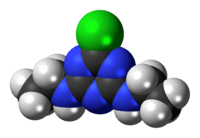Simazine
 | |
 | |
| Names | |
|---|---|
| IUPAC name
6-Chloro-N,N'-diethyl-1,3,5-triazine-2,4-diamine | |
| Identifiers | |
| 122-34-9 | |
| 3D model (Jmol) | Interactive image |
| ChEBI | CHEBI:27496 |
| ChEMBL | ChEMBL1605837 |
| ChemSpider | 5027 |
| ECHA InfoCard | 100.004.124 |
| KEGG | C11172 |
| PubChem | 5216 |
| |
| |
| Properties | |
| C7H12ClN5 | |
| Molar mass | 201.66 g·mol−1 |
| Appearance | White crystalline powder |
| Density | 1.3 g/cm3 |
| Melting point | 225–227 °C (437–441 °F; 498–500 K) |
| 5 mg/L | |
| Solubility in other solvents | Soluble in methanol, chloroform, and diethyl ether; slightly soluble in pentane |
| log P | 1.9600 |
| Vapor pressure | 0.000810 mPa at 20 °C |
| Except where otherwise noted, data are given for materials in their standard state (at 25 °C [77 °F], 100 kPa). | |
| | |
| Infobox references | |
Simazine is an herbicide of the triazine class. The compound is used to control broad-leaved weeds and annual grasses.
Preparation
Simazine may be prepared in the laboratory from cyanuric chloride crystals and a strong solution of ethyl amine (at least 50 percent by number in water). The reaction is highly exothermic and is therefore best carried out in an ice bath below 10 °C. It is also essential to carry out the synthesis in a fume hood since cyanuric chloride decomposes at high temperatures into hydrogen chloride and hydrogen cyanide, both of which are highly toxic by inhalation.
Properties and uses
Simazine is an off-white crystalline compound which is sparingly soluble in water. It is a member of the triazine-derivative herbicides, and was widely used as a residual nonselective herbicide, but is now banned in European Union states.[1] Like atrazine, a related triazine herbicide, it acts by inhibiting photosynthesis. It remains active in the soil for 2-7 months after application.
See also
References
- ↑ EU directive 91/414/EEC
External links
- Simazine, Extoxnet PIP